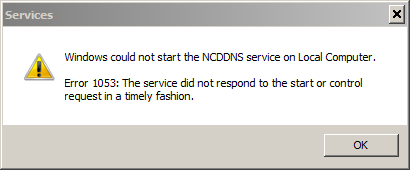Namecheap provides a free Dynamic DNS client for Windows but unfortunately the client cannot be run as a service. To manage remote computers, the dynamic DNS update should at least run before any user is logged or we’ll run into a chick-and-egg problem: you want to log in remotely but the IP of the remote computer is not known (mapped/updated) until you logged in.
I initially tried to use sc.exe to create a Windows service but the program lacks a ServiceMain() implementation so the service won’t start:

Turns out there is a way to wrap a Windows executable not designed to be used as a service (without ServiceMain() implementation) and make it run as a service. Use a tool called NSSM – the Non-Sucking Service Manager!
Note that the default setting for “Log on as” is “Local System Account”, which will not work with this free Namecheap Dynamic DNS client. You must set it to “Log on as” an Administrator account.
To start the newly created service without rebooting, do nssm start <servicename>, where <servicename> is replaced by the name you choose for the service.
Note that the ‘Path to executable’ for the newly created service is nssm.exe itself, not directly the DNS update client program (like what it’d be if you create the service through sc.exe instead of nssm.exe). The reason is that nssm.exe is the wrapper that calls the underlying executable.
![]()
